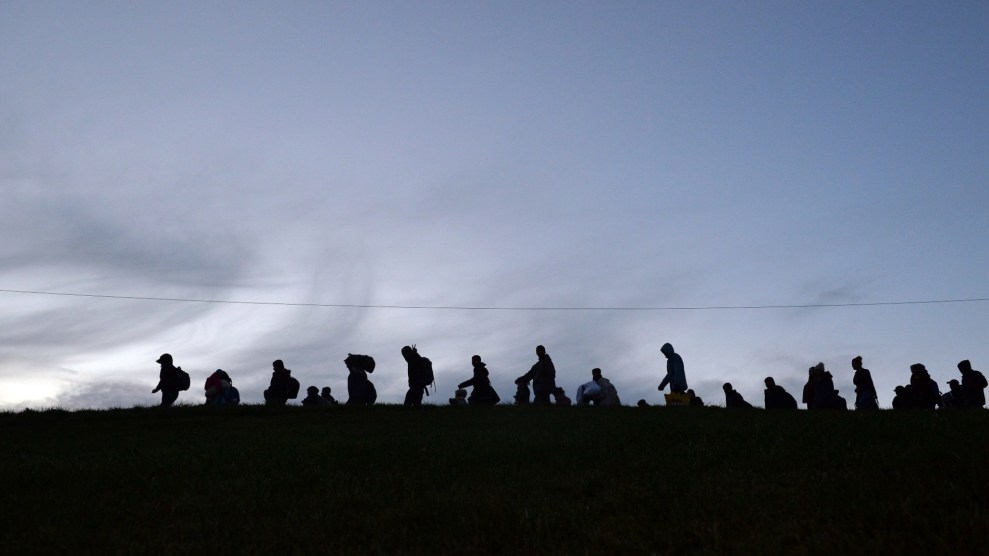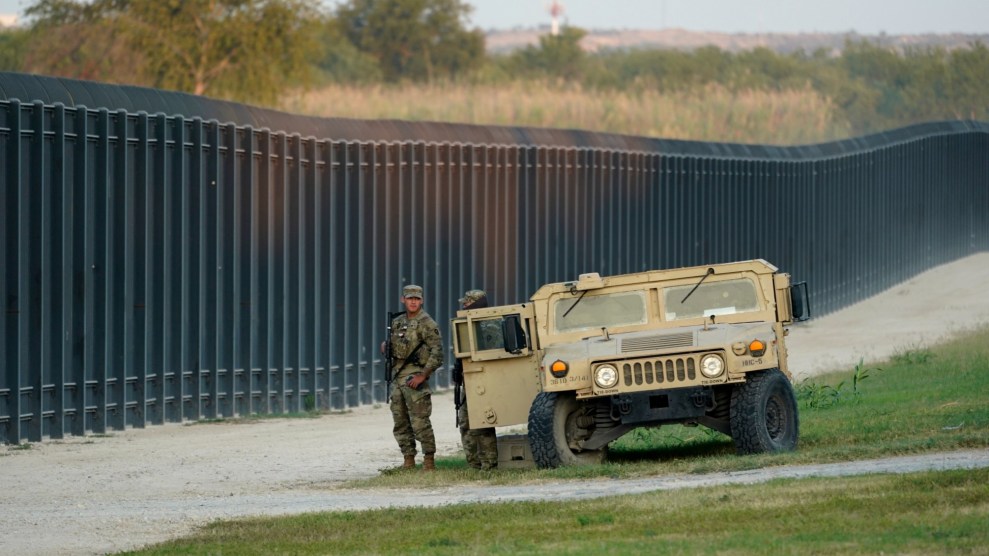Early Saturday morning, the room on the fourth floor of the Washington, DC, church is full. It’s not yet 7 a.m. and already about sixty migrants, mostly men and a handful of families with children, some women breastfeeding, sit around nine round tables. Their scant belongings—keepsakes of the homes they had left behind and tokens of solidarity from strangers they encountered along the way—are preserved inside transparent Ziplocs and white trash bags. After a 1,700-mile, 40-hour journey from Texas, two of the more than 150 buses transporting migrants that Texas Gov. Greg Abbott has sent to Washington, DC, had arrived at Union Station at dawn. One woman approaches me to ask where she can take a shower, telling me she really needs to clean up. Another wonders if she can have a new pair of shoes because the cheap rubber sandals on her feet are falling apart. Some people need diapers and ointment for their babies; others ask around for some medicine that could relieve a headache.
David Swanson, a 60-year-old compliance manager with the Human Rights Campaign finance department volunteers at the church every other weekend. (Mother Jones is not disclosing the location of the church or the migrants’ full names to protect their identities.) Since the church started receiving migrants in late May, over a month after they began arriving in the city, he has met people from all over the world—Venezuela, Guatemala, Honduras, Haiti, and even Afghanistan. During one of his shifts, a volunteer who happened to be a pediatrician noticed a woman who had surgical staples all over her chest. Swanson recalls that she had been shot many times, then hospitalized, but left her home country before she could get them removed. Another man had told him that he felt “a little bit like a prisoner” when he saw his final destination—Nashville, Tennessee—fly by the window as his bus raced towards the east coast without making a stop.
This Saturday in August, Swanson is cooking breakfast for a group he had anticipated would number about 23 people. The gathering had more than doubled, and it turned out to be the biggest group the church had welcomed in a while. Dressed in an apron, Swanson started at 5 a.m. and prepared 130 eggs and eight rolls of pork sausage to be served with slices of melon, mandarin oranges, white bread, coffee, and apple juice. Still, he worries there might not be enough food for everyone. “Luckily we had a lot of leftover eggs from last week,” he tells me. Nearby, a young man thanks a volunteer, saying he hadn’t had a proper meal in several days. A mother breastfeeding a cheerful eight-month-old boy tells me she is happy to drink coffee for the first time in more than a week. Like so many people in the room, she and her husband hope to leave soon for New York.
“We mostly stay out of the way and let them do their work,” Swanson says of the volunteers with the Migrant Solidarity Mutual Aid Network, a coalition of about 20 grassroots groups from the DMV area and countless individuals who have mobilized to receive the buses at Union Station. “They work like a machine,” he says, coordinating with churches and other faith-based organizations to provide assistance and orientation to the migrants.
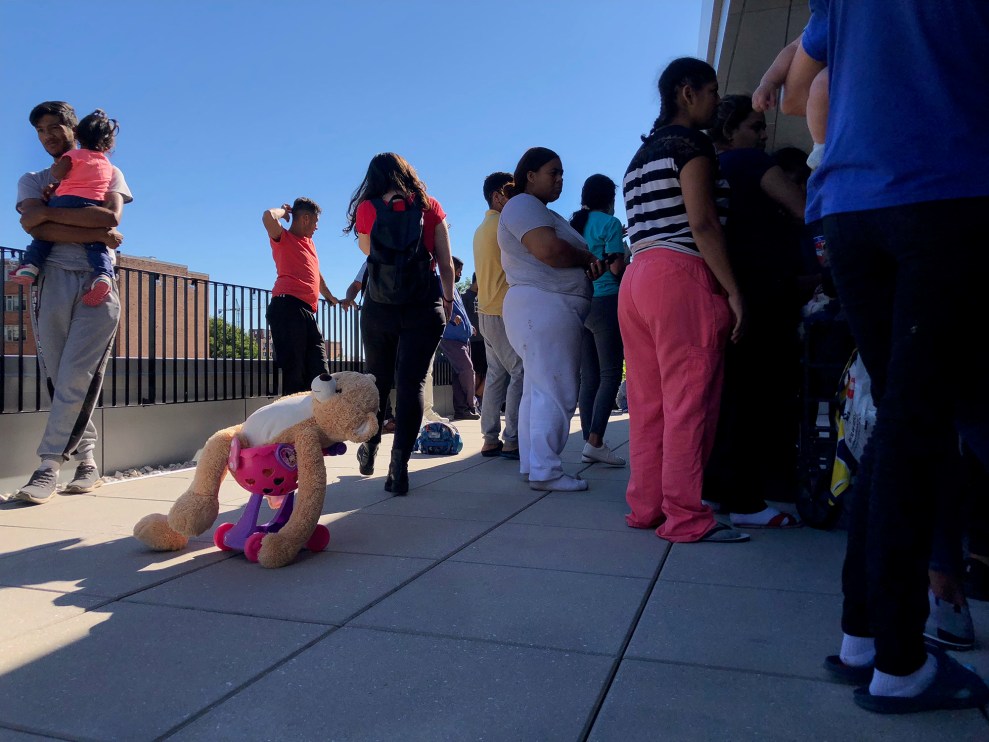
A group of about 60 migrants arrived at a Washington, DC, church on a Saturday in August.
Isabela Dias
The migrants, most of whom came from Venezuela, are unaware that they have become the most recent pawns in a political game carried out by Republican governors. The first bus from Texas arrived in DC on April 13 with about 30 passengers on board. It was part of what Abbott described as a “voluntary transportation” plan but what advocates and the White House have dubbed a “publicity stunt.” The Texas governor said he was responding to the Biden administration’s move to rescind a Trump-era policy that relied on a public health order to summarily expel migrants and asylum seekers coming to the US-Mexico border. (The policy remains in place pending further litigation.) “By busing migrants to Washington, DC, the Biden Administration will be able to more immediately meet the needs of the people they are allowing to cross our border,” Abbott, who is seeking a third term in office, said in a statement at the time. “Texas should not have to bear the burden of the Biden Administration’s failure to secure our border.”
Since April, Abbott has dispatched a total of 6,500 migrants to the Nation’s Capital, which has scrambled to try to deal with the arrivals. In early August, Texas also started sending migrants to New York, where they’re being dropped off at the Port Authority bus terminal. So far, the Texas Division of Emergency Management has spent millions of dollars in taxpayer money to charter the buses. A crowdfunding campaign organized by the governor’s office to help offset the costs had raised $167,828 as of August 17. In May, the Republican governor of Arizona Doug Ducey also began to bus migrants to DC—costing the state at least $3 million. The hostile practice has received criticism even from some Republicans who have called it a gimmick and a “cute photo-op.” The goal, Hidetaka Hirota, associate professor of history at the University of California, Berkeley, and author of Expelling the Poor: Atlantic Seaboard States and the Nineteenth-Century Origins of American Immigration Policy, writes in the Washington Post, is to “embarrass pro-immigration politicians and create the appearance of chaos to justify cruel policies.”
Among the volunteers at the church is Diana Fula, a Colombian-born case manager for social services at Ayuda, a nonprofit organization helping low-income immigrants. She wears a bright blue t-shirt that reads “Melt ICE” in reference to US Immigration and Customs Enforcement (ICE), the agency that detains immigrants. She addresses some of the migrants by “compa,” a shorthand for compañero, or companion. Fula helps sort through the pile of donated clothes the church has collected, some of which were originally meant for Afghan refugees, and now fill racks and boxes in a large empty space on the third floor of the church building. “Families with kids first,” she says in Spanish as people start lining up in the balcony.
After breakfast, Fula tells everyone it’s time to start the intake process. About six volunteers collect information about the migrants’ country of origin, date of birth, special circumstances (LGBTQ+, pregnancy, chronic illness), final destination, and point of contact. In a sunny corner of the room, telephone numbers for organizations in places such as Wisconsin, Florida, Massachusetts, Chicago, Georgia, and Nebraska are listed on a whiteboard. Migrants have received cell phones used by ICE to track them, Fula explains, and she might need to follow up so they don’t miss their check-in appointments and immigration court dates in the future. When a man asks her about the New York address on his papers, she urges him to confirm that he has the correct direction to a men’s shelter. “Sometimes immigration [officials] will put addresses that don’t even exist,” she notes.
The migrants, Fula says, “are desperate to save their lives.” And the lives of their families. Five years ago, Esaviel, a slim-built 39-year-old Venezuelan wearing a t-shirt with the words “always courage,” traveled to Brazil to try to provide for his now 11-year-old daughter who had been diagnosed with Type-1 diabetes. But work proved scarce. The family then moved to Colombia, where Esaviel’s daily pay as a construction worker was worth a month’s salary in Venezuela. He invested much of his savings into buying tools, which he then sold before leaving for the United States. “I came here for my daughter,” he says showing me a piece of paper that details her medical condition. He has been carrying that paper for 21 days. “I want her to have a normal life.”
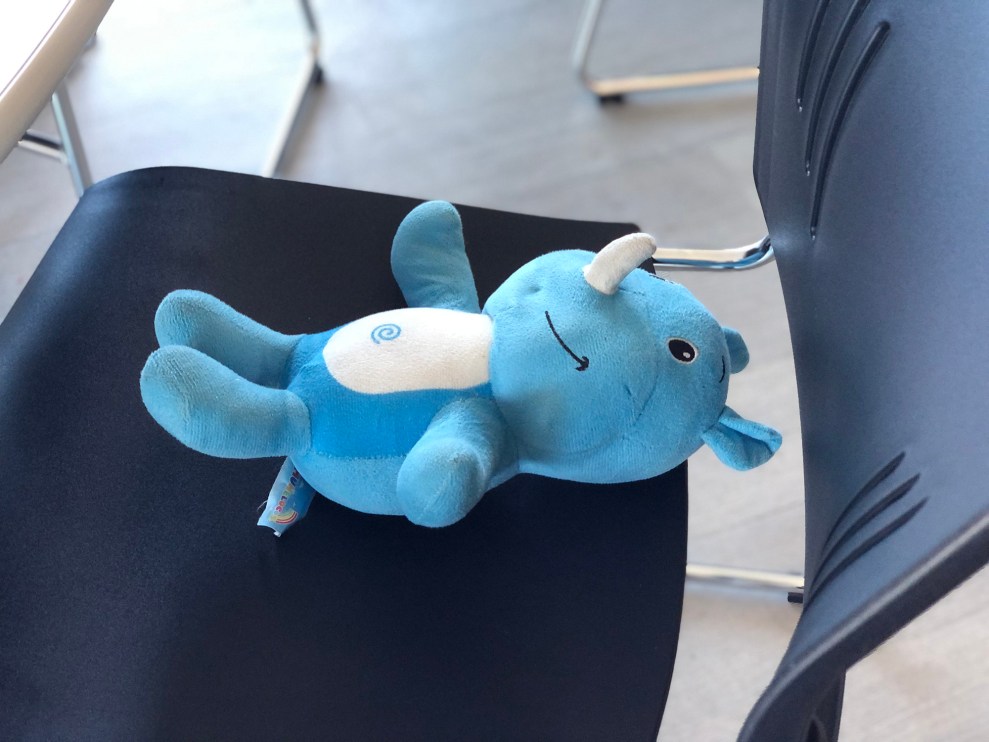
Families with young children were among the migrants who arrived in DC on buses from Texas.
Isabela Dias
The buses to the DC have been arriving almost every day of the week, sometimes multiple times a day and often early in the morning and late at night. According to volunteer groups, only between 10 to 15 percent of migrants actually choose to stay in the DMV area. For those who are lucky, the “free ride” might get them closer to their desired destination, perhaps where family members await—whether in New York, New Jersey, Florida, or Michigan.
Some larger organizations like the international humanitarian nonprofit SAMU First Response, which received a $1 million grant from the Federal Emergency Management Agency (FEMA), have been designated to provide immediate assistance at Union Station. But community groups and volunteers have had to step in to fill the gaps. By July, at the peak of arrivals, two to five buses arrived on a daily basis, and volunteers worked around the clock to send dozens of people to their next stops, says Ashley Tjhung, an organizer with the Migrant Solidarity Mutual Aid Network. (In a few months, the coalition’s expenses have soared to $300,000, to cover food, housing, transportation, and medical assistance.)
Those staying in DC have spent nights outside the station or in shelters, where bed space is limited. Some are put in hotels. But without being enrolled in the Department of Human Services system they lack a permanent address and don’t get assigned case managers to help them access basic services. “We have a network of volunteers who host migrants long-term in their homes and have been doing so for months,” Tjhung says, adding that the network also helps people make rent, get groceries, and find transportation to ICE appointments.
But volunteers also know the workload is not sustainable in the long run. Advocates point to one potential model in the city of San Antonio, which established a FEMA-funded migrant resource center last month. “We recognize that these nonprofits are understandably strained and simply cannot be expected to carry this responsibility alone,” DC’s Attorney General Karl A. Racine Tweeted last week when announcing a new grant program. “The biggest issue we’re facing now is the lack of response from the DC government itself,” Tjhung says. “We’re calling on the mayor to change her stance and live up to DC values as a sanctuary city.”
For her part, DC Mayor Muriel Bowser recently asked the federal government to deploy 150 members of the National Guard to respond to what she called a “growing humanitarian crisis.” The Pentagon denied the request. “I have got to deploy the resources that I need to handle it,” Bowser said. “And we need our National Guard. If we were a state, I would have already… deployed the National Guard. We also need a federal site. If there are going to be ongoing busloads of people who are stopping here on their way to where they’re going—which is not here—we need a site that the NGOs can use to make that… stop as humane as possible for people who are fleeing horrendous circumstances. In many cases, those people are boarding buses having been lied to about what’s going to be on the other end, and then they’re still not where they want to be. So we really need federal coordination.”
I got to Union Station just before 10 p.m. earlier in the week, arriving around the same time as a group of about 17 migrants entered the main hall. The men, who appeared to be mostly in their late teens or early twenties, had just gotten off a bus and carried brown envelopes. They huddled together as they waited to give four SAMU volunteers their information. Some were making calls to family members and eating pizzas the volunteers had brought. “They’re being thrown back and forth,” Diego Anjos, a Brazilian pastor with the Universal Church of the Kingdom of God told me, explaining that he had decided to go to the station to see how he could help.
Jesus, a 21-year-old from Venezuela, had been traveling for nearly six weeks since July 1. That was the first time he had left the country. Although he had finished his third year in law school, he saw no prospects in crisis-ridden Venezuela. “There, if you have money you eat, if not you don’t,” he said. In a backpack he acquired along the way, Jesus carried a pair of sneakers and socks, coins from the countries he had crossed, and a letter from his eight-year-old brother. He had carefully placed the paper inside two plastic bags, but it had been reduced to shreds, perhaps a casualty of the river crossing. His brother’s drawing of a heart and an arrow were still visible.
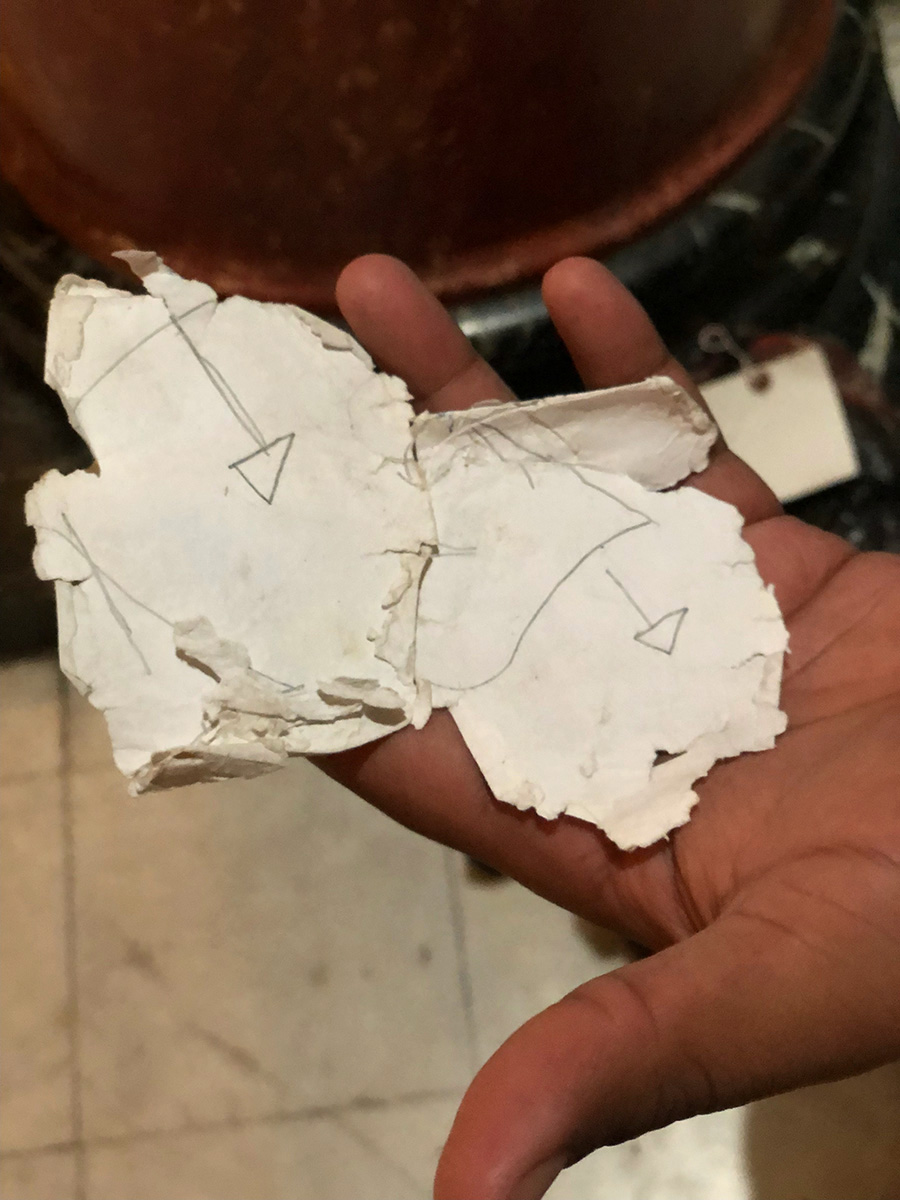
A migrant shows what’s left of his brother’s letter.
Isabela Dias
“People have seen some unimaginable, heartbreaking things,” Reverend Lisa Ahuja from a DC-based church that welcomes migrants says. The church has hung a big map so that people can talk about their plans and future destinations. It has also started offering Spanish language worship services on weekends. Sometimes migrants ask her to pray for their family members or those who had died along the journey. “While they seem hopeful for the life ahead of them, they are also longing and grieving for the life they had,” Rev. Ahuja says, explaining she worries about the migrants’ mental health needs and hopes to apply for a grant so she can hire a social worker and a therapist. “This [work] takes half of my time,” she says. “It’s not my full-time job; I still have to run a church, visit the dying… But I know this is the most important thing we can be doing.”
“They’re our neighbors,“ Rev. Ahuja adds, “our community members now.”
On a hot, beautiful, August Thursday, Daniele sits across from me outside a Gregorys Coffee downtown. “The heat doesn’t bother me,” she tells me in Spanish, her eyebrows and manicure impeccably done, and her dark curly hair tied on top of her head with a scarf. “I’m used to it.” It’s been a little over a month since Daniele, who asked me not to use her real name because she has a pending application for asylum, arrived in one of the hundreds of buses from Texas. The 26-year-old from Venezuela appears in awe of how clean and well-kept the public spaces in the city are and how multicultural it is. She never imagined that she would end up in Washington, DC, but now, because of the Texas governor’s political stunt, she’s calling it home.
In Venezuela, Daniele served in the military and dreamed of becoming a Navy pilot. But as the political crisis in the country worsened, she decided to abandon her military career and migrate to Ecuador. “It’s very sad to see so many of your dreams going down the drain for circumstances that are outside of your control,” she says. “I planned all my life and none of it came to fruition. Look at where I am now. I’m adrift.” The xenophobia in Ecuador, she says, made her life harder—rental listings explicitly stated they didn’t accept Venezuelans and visas that cost five times more than for other nationalities. So, on May 20 she began the journey to the United States with a group of 18 people.
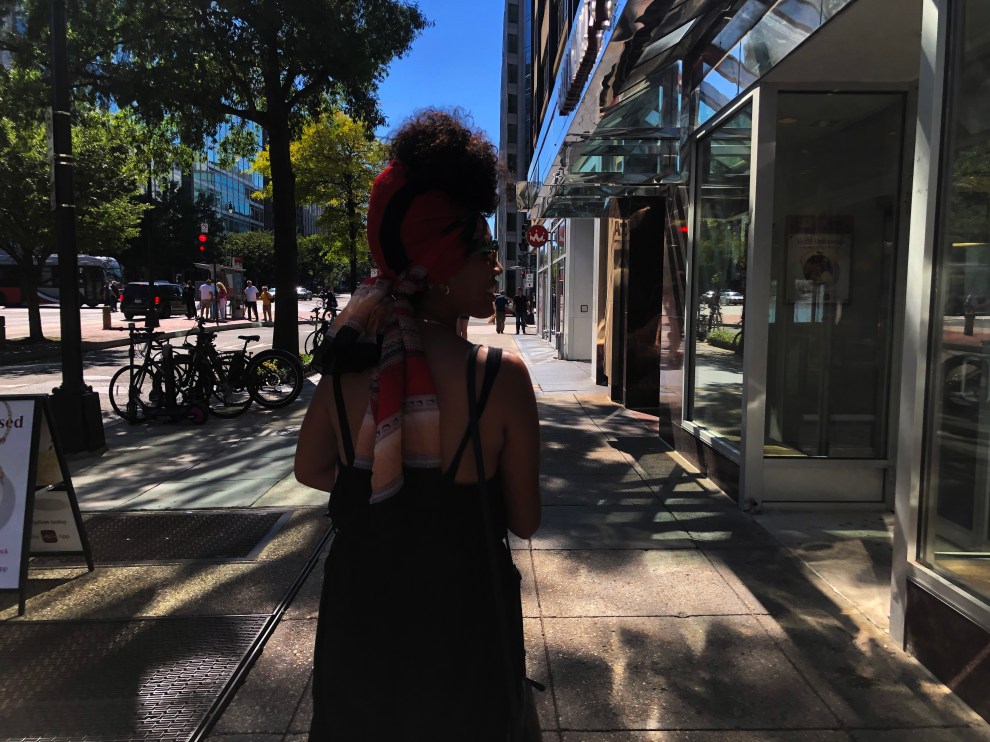
Daniele walking in Downtown DC.
Isabela Dias
Crossing the Darien Gap between Panama and Colombia was the hardest stretch. She spent three days and two nights in the jungle. “When you get to the jungle there are more than 500 people searching for the same dream,” she says. “And it’s not the American dream. It’s a dream of giving your family something better. You know that something can happen to you but for your family, nothing else matters. You risk everything you have and everything you are.”
Along the way, Daniele says she slept in the streets and got extorted, kidnapped, and detained. After walking for three days from one Mexican town to the next she arrived at Piedras Negras on the border with Texas. As she crossed the river with water up to her neck, she cried and felt safe for the first time in a while. “From the moment I stepped on US soil,” she says, “it was as if a weight was lifted off my shoulders.” After being taken to a border facility for processing, Daniele was released and spent one night at a shelter where they told her about the bus to DC, on which she estimates she traveled with about 70 other migrants.
Daniele arrived in DC on the night of July 5 and connected with a church, where she met a woman who lives alone and welcomed her into her home. “She’s like a second mother,” she says. “We help each other a lot and keep each other company.” Some Wednesdays, Daniele volunteers at the church that first received her, helping the migrants who continue to arrive. She knows she has a long road ahead of her. She isn’t allowed to work and it may take months for her asylum application to go through. But for the time being, she has found peace. “I want to stay here,” she tells me. “I’m happy where I am.”
As I reflect on the people I had encountered—Daniele, the eight-month-old baby and his mother, the young men eating pizza at Union Station—I think about all the uncertainty that will follow them and the scores of other migrants who were now in buses bound for DC or New York. How long will it take for them to get back on their feet? Whose generosity might they have to rely on next? Then I remember Esaviel, whose daughter’s survival kept him going. “Someone who’s desperate doesn’t make it through,” he told me. “You have to have a strong mind.”

